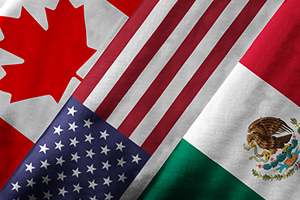
The U.S., Mexico, and Canada released text to modernize the North American Free Trade Agreement (NAFTA) on September 30, 2018. While many news outlets reported on the new agreement—including the fact that all three countries still must ratify the trade agreement, which is likely to occur in 2019—there hasn’t been much information about how the agreement is likely to change for freight. Here are the main differences we see, which should provide significant optimism for those with cross-border shipments.
A Closer look at the new USMCA agreement
It is important to note that this text of the agreement will be voted on as a whole and is not likely to change, save for clear clerical drafting errors. The details of USMCA Chapter 7: Customs Administration and Trade Facilitation will dictate the operating rules and goals for cross-border shipments for decades to come. Supply chain professionals who want a deeper dive into this title will find a useful overview in Advisory Committee Report on Trade Facilitation Title of USMCA.
Below are just some of the primary highlights, with the applicable sections of the new agreement noted.
De Minimis
De Minimis—the minimum value of the goods below which no duties and taxes are being collected by Customs authorities—would change.
Current De Minimis:
- For Canada, $15 (CAD), no duty or taxes payable
- For Mexico, $50 (USD), no duty or taxes payable
- For the United States, $800 (USD), no duty and taxes not applicable
Future De Minimis under USMCA:
- For Canada, $40 (CAD), no duty or taxes payable and $150 (CAD), no duty payable but subject to taxes (GST, HST, DTA, etc.)
- For Mexico, $50 (USD), no duty or taxes payable and $117 (USD), no duty payable but subject to taxes (GST, HST, DTA, etc.)
- For the United States, $800 (USD), no duty and taxes not applicable
Goals and mandates for more uniform treatment across ports and border crossings
In the past, border crossings in a single country might have different documentation requirements, or value calculations might differ by port in the same country. According to the new agreement:
- Port specific procedures or requirements for documentation have been prohibited (Section 7.11).
- Rulings regarding value calculation or tariff application must be honored uniformly across all ports (Section 7.6).
Greater systems synchronization, especially with partner government agencies
- Electronic document submissions will be treated equally with paper documents (Section 7.7.2.b and 7.9.c).
- There are requirements to alert importers about which agency is holding up the release of goods (Section 7.7.2.d).
- There are requirements to alert importers of information (such as confirmation of release) through a single window platform (Section 7.10).
Improvements in the administration of rules
- Rules and processes will be published online (Section 7.2).
- Extra penalties for self-reported correction of errors or misclassification would be eliminated (Section 7.18.7).
- A standing cross-border committee would be established to address issues (Section 7.22 and 7.30).
Customs brokerage improvements
- Limits on the number of ports where a customs broker can file are eliminated (Section 7.21.3).
- Requirements to become a customs broker must be clearly published online (Section 7.21.2).
Final Thoughts
While each of these new provisions individually are welcomed, taken together, they will mark a significant improvement for faster, safer, and more efficient trade facilitation across North America.
If you need further assistance in understanding how the new agreement might impact your cross-border business, please contact a C.H. Robinson expert in Customs.



